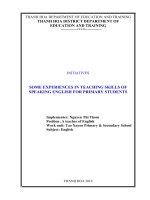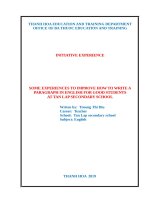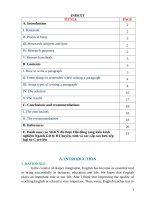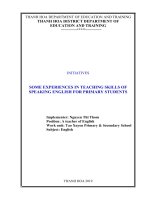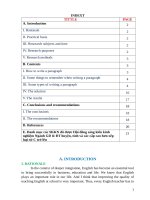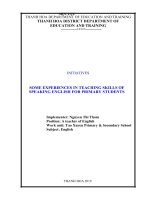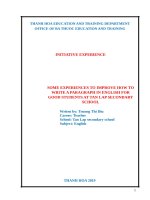ENGLISH FOR LAW STUDENTS UNIVERSITY COURSE PART II
Bạn đang xem bản rút gọn của tài liệu. Xem và tải ngay bản đầy đủ của tài liệu tại đây (2.09 MB, 672 trang )
M.V. Lomonosov Moscow State University
Law School
Department of Foreign Languages
ENGLISH
FOR LAW STUDENTS
UNIVERSIT Y COURSE
Part II
Рекомендовано Учебно-методическим объединением
по юридическому образованию высших учебных заведений
в качестве учебного пособия для студентов высших учебных заведений,
обучающихся по ôằ
ôằ
èẻẹấ 2016
УДК 802/809.1
ББК 81.2
Е 58
EDITED BY
Tatiana Tarasova
CONTRIBUTORS:
Natalya Berezhneva,
Asya Goloborodko,
Dina Karpova,
Tatiana Patenkova,
Tatiana Tarasova
REVIEWED BY
Suren Avakjan, Professor of Law,
Eugenia Yakovleva, Professor of Linguistics,
Anna Lebedeva, Professor of Liguistics
Е 58 English for Law Students: University Course / Ed. by T. Tarasova. Part II. –
Moscow: STATUT, 2016. – 672 p. [Английский язык для студентов-юристов. – М.: Статут, 2016. – На английском языке]
ISBN 978-5-8354-1138-2 (Part II; softback)
ISBN 978-5-8354-0977-8
ENGLISH FOR LAW STUDENTS is a part of the university course of
legal English for academic purposes. It is addressed to law students of noncommon law countries. It is aimed at teaching students to understand the
language of Anglo-American legal system, its fundamental concepts and
institutions. Its goal is to enable students to deal with different types of legal
texts, to become knowledgeable in current legal issues, to use proper English
legal terms with regard to their own legal systems. The final objective is to
stimulate students’ interest in law and language. Although English for Law
Students is designed as a part of the university course of legal English it can
also be useful for students of the humanities, economics, social and political
sciences, etc. in their self-study of English law and language.
ISBN 978-5-8354-1138-2 (Part II)
ISBN 978-5-8354-0977-8
УДК 802/809.1
ББК 81.2
© Contributors, 2015
© Издательство «Статут»
(Statut Publishing House), 2015
CONTENTS
Foreword.............................................................................. 6
UNIT I
THE HISTORY OF THE U.S. CONSTITUTION
Text 1. The Need for a New Constitution.............................. 8
Text 2. The Actual Writers of the Constitution.................... 25
Text 3. “We the People of the United States”...................... 42
Text 4. Ratification of the Constitution............................... 58
Text 5. The First National Government under
the Constitution...................................................... 70
UNIT II
AMERICAN CONSTITUTIONALISM:
ORIGINS AND PRINCIPLES
Text 1. The Origins of American Constitutionalism............. 83
Text 2. American Circumstances....................................... 107
Text 3. The American Constitutional System:
Principal Characteristics....................................... 131
UNIT III
U.S. CONGRESS
Text 1. Historical and Constitutional Background
of Legislative Power.............................................. 152
Text 2. Congress Membership........................................... 168
Text 3. Sources of Legislation........................................... 181
Text 4. Introduction and Referral to Committees.............. 190
Text 5. Senate Action........................................................ 202
3
CONTENTS
Text 6. Congress’s Investigative Oversight Role................. 215
Text 7. The Enactment Process......................................... 225
Text 8. The Party Organization......................................... 231
Text 9. Representative Government.................................. 238
UNIT IV
U.S. PRESIDENCY
Text 1. The Chief Executive.............................................. 246
Text 2. The Power of Appointment................................... 257
Text 3. Enumerated, Implied, Inherent Powers.................. 268
Text 4. The Treaty-Making Power..................................... 277
Text 5. Executive Agreements............................................ 289
Text 6. The Presidential Veto............................................. 300
Text 7. The President as Legislator.................................... 308
Text 8. Impeachment........................................................ 324
Text 9. The Intent of the Framers Versus
the Modern American Presidency.......................... 332
UNIT V
THE ORGANIZATION OF COURTS
IN THE UNITED STATES
Text 1. State Courts v. Federal Courts................................ 347
Text 2. The Structure of American Courts..........................361
Text 3. Consequences of the Dual Court System................ 379
Text 4. The Administrative Organization of Courts............ 392
UNIT VI
THE UNITED STATES SUPREME COURT
Text 1. The Court and Constitutional Interpretation........... 411
Text 2. The Court as an Institution.................................... 428
4
CONTENTS
Text 3. Constitutional Guide and Modern
Developments....................................................... 448
Text 4. The Court and its Procedures................................ 466
Text 5. A Unique Court.................................................... 479
Text 6. Judicial Review...................................................... 502
Glossary........................................................................... 526
Keys................................................................................. 652
References.........................................................................671
FOREWORD
English for Law Students PART II is designed
• to meet the students’ needs in acquiring both language
through law and law through language;
• to strengthen their reading and writing skills;
• to develop the students’ ability to analyze, summarize and
interpret legal texts concerning particular legal area or
issue;
• to introduce common law terms, concepts and institutions
to the students of a non-common law system;
• to increase their competence in legal language usage;
• to provide thought provoking materials;
• to encourage analytical approach to and comparative
studies of current legal issues and reforms;
• to equip students with linguistic tools to advance in their
scholarly activity.
English for Law Students contains six UNITS: The History
of the U.S. Constitution, American Constitutionalism:
Origins and Principles, U.S. Congress, U.S. Presidency, The
Organization of Courts in the United States, The United States
Supreme Court. Each unit includes a number of texts on a
particular theme followed by LANGUAGE PRACTICE and
COMPREHENSION CHECK with TASKS ranging from word
building to complicated legal vocabulary, grammar, syntax,
discussion points. They focus on reading comprehension,
speaking and writing activities. Each unit ends with the task to
write an essay based on the texts of the unit which make up one
of the exam questions.
6
Foreword
The KEY at the end of the book gives the answers to some
exercises.
The GLOSSARY provides definitions for most legal terms
used in the units.
English for Law Students PART II is designed for all those who
strive for academic excellence and professional success.
UNIT I
THE HISTORY OF THE U.S. CONSTITUTION
TEXT 1
The Need for a new Constitution
PRE-READING QUESTION:
1. Was the U.S. Constitution the first one in history?
2. Were there other early Constitutions?
1. For most of modern history the word constitution has
meant the entire legal framework of a nation. For example,
the English “constitution” includes the Magna Charta of 1215,
which was the first written set of restrictions on kingly power,
the Petition of Right of 1628, the English Bill of Rights of 1689,
the Reform Bills of 1832 and 1867, many statutes, judicial
decisions, and royal pronouncements, as well as common law
and established government customs and usages. Thus, the
English constitution is both much less than and much more than
a written constitution such as the American one. In fact, a written
constitution – setting forth a plan of government, establishing
its institutions, and proclaiming the rights of citizens – is a
relatively new development.
2. Although claims have been made for the Mayflower
Compact of 1620, the 1630 Charter of the Massachusetts Bay
Colony, and the 1639 Fundamental Orders of Connecticut,
many scholars agree that the first written constitution of
8
THE HISTORY OF THE U.S. CONSTITUTION
government was England’s 1653 Instrument of Government.
The Instrument, which set out a new, republican form of
government, and its 1657 successor, the Humble Petition and
Advice, were swept away by the Restoration of Charles II in
1660 and had almost no influence on either English or American
constitutional development, but they did presage many later
reforms in England.
3. The English colonists in North America regarded
themselves as Englishmen possessing all the rights of
Englishmen, even though they lived thousands of miles away
from the mother country. Each colony had some form of
written instrument of government by the eighteenth century,
usually a royal charter. Originally, there were three types
of colonies: joint-stock companies, organized as economic
ventures under a charter granted by the Crown conferring
certain privileges, as with trade (for example, Virginia and
Massachusetts Bay); compacts, agreements reached by and
among the colonists themselves (Plymouth; Providence,
R.I.; Fundamental Orders of Connecticut); and proprietary
colonies, in which the Crown granted the land composing the
colony to one or more landholders known as proprietors. By
the mid-eighteenth century, most of the colonies were royal
colonies, in which the former joint-stock company or compact
form had been replaced by direct royal authority residing in
the governor. In Maryland, Pennsylvania, and Delaware,
the proprietors (not the Crown) appointed the governors; in
Connecticut and Rhode Island, the surviving charter colonies,
the colonists themselves chose their governors. Each colony
also had a two-house, or bicameral, legislature; the lower house
was elected by those colonists who could meet qualifications
based on the amount of real or personal property they had,
while the upper house was selected by the lower house. The
upper house, or council, had both legislative and executive
9
UNIT I
powers and duties, in that it also advised the governor on a
daily basis. The royal charters that most colonies possessed
became the focus of disputes between the colonists and their
governments, with the colonials challenging what they saw as
arbitrary and unconstitutional exercises of power.
4. The initial stages of the American Revolution were
moves and counter-moves in an intricate but fierce struggle
to determine the limits of Parliamentary authority. Parliament
retained supreme legislative power over the colonies, while at
the same time other key agencies, such as the Privy Council,
the Secretary of State, the Treasury, the Admiralty, and the
Board of Trade, also had responsibility for colonial affairs,
with the result that for most of the seventeenth and eighteenth
centuries British administration of the colonies was entangled
in bureaucratic infighting and prey to incompetence and
mismanagement.
5. In May of 1776, anticipating its action two months later
in the Declaration of Independence, the Second Continental
Congress passed a resolution calling upon the colonies to
prepare new, written constitutions in case it became necessary
for them to separate from England. A few colonies merely
modified their old charters, deleting all references to the king and
England, but within the next few years most prepared entirely
new, republican constitutions. These reflected the Americans’
concern with arbitrary power, particularly arbitrary executive
power. Pennsylvania’s constitution of 1776 even did away, with
a separate executive, establishing instead a Supreme Executive
Council chosen by and under the thumb of its one-house
legislature. Other states provided for a weak governor and a
powerful two-house legislature. Still others, notably New York
in 1777 and Massachusetts in 1780, created an independent
governor, who was armed with veto power over legislation
(although New York’s constitution granted only a qualified veto
10
THE HISTORY OF THE U.S. CONSTITUTION
power to a council of revision composed of the governor and
several state judges), and a system of checks and balances among
the legislative, executive, and judicial branches of government.
Massachusetts’s most significant contribution to American
constitutional thought was a stipulation mandating ratification
of its constitution by the people in special conventions called for
that purpose. Previous state constitutions merely went into effect
after being adopted by their legislatures. The Massachusetts
idea recognized the distinction between constitutions and mere
statutes. Its constitution – chiefly the work of John Adams – and
the New York one – largely that of John Jay – were important
models and sources for the subsequent framing of the U.S.
Constitution.
NOTES TO THE TEXT
John Jay (1745–1829) – a Founding Father of the United States
who served the new nation in both law and diplomacy. He established
important judicial precedents as the first Chief Justice of the United
States (1789–1795) and negotiated the Jay Treaty of 1794, which
settled major grievances with Great Britain and promoted commercial
prosperity.
John Adams (1735–1826) – a leader of the American Revolution, the
second U.S. President (1797–1801) defeated for another term by Thomas
Jefferson (1743–1826). Adams – America’s first Vice President. During
his presidency, Washington became the American capital.
Mayflower – the ship in which the Pilgrim Fathers sailed from
Southampton to the New World in 1620.
LANGUAGE PRACTICE AND COMPREHENSION CHECK
ACTIVE VOCABULARY
to presage, humble, to entangle (in), prey (to), venture,
proprietary, stipulation, arbitrary, intricate
11
UNIT I
TASK I. a) Match the words to their definitions:
1) to presage
2) to entangle (in)
3) prey (to)
4) venture
5) humble
6) intricate
7) arbitrary
8) proprietary
9) stipulation
a) be seized by, caught by, harmed or
affected in a bad way by
b) foretell, be a sign of
c) put or get into difficulties, in
unfavorable circumstances
d) having many complexly
interrelating parts or elements
e) not restrained or limited in the
exercise of power
f) a material condition or requirement
in an agreement; provision
g) owned or controlled by, held as
property
h) an undertaking involving chance,
risk, or danger
i) reflecting, expressing, or offered in a
spirit of deference or submission
b) Use the above words to complete the following sentences:
1. An artificially strong euro may … strong problems for the
country.
2. The refugees fell … to criminal gangs.
3. The Court articulated several … that had to be met to
sustain a political gerrymandering claim.
4. A tax incentive violates the commerce clause when it has
the effect of providing lower tax rates to in-state businesses than
those imposed on out-of- state ….
5. The law … the interests of church and state by seeking
“the symbolic and financial support of government to achieve
a religious purpose.”
12
THE HISTORY OF THE U.S. CONSTITUTION
6. Holmes was both proud and … about his war service.
7. The ruling in Board of Regents v. Roth … subsequent cases
that did expand the rights of terminated employees.
8. Federal funding for private universities may come with
congressional … protecting student rights.
9. The courts have upheld the constitutionality of the
death penalty but looking more closely at how it is applied,
held that an … or discriminatory application would be
unconstitutional.
10. The Court ruled that it was not a violation of the due process
clause of the Fourteenth Amendment for the state legislature to
regulate the price of a necessary good such as milk, as long as the
regulation was not … or unreasonable.
11. The policy would … the nation in conflicts that could
easily lead to war.
12. There are few … regarding qualifications for becoming a
senator, as is the case for representatives.
13. Initially, the father had extensive powers over the family,
including the power of life and death; until Justinian’s time, the
father alone in his familia had … capacity.
14. Hylton v. United States case is important historically, as
it … Marbury v. Madison.
15. True … rights are ‘binding on the world’ in the lawyer’s
traditional phrase.
c) Translate the following sentences:
On the other hand, the highly-debated establishment by
Congress of a process by which independent special prosecutors
could be established to investigate and prosecute cases of alleged
corruption in the Executive Branch was sustained by the Court
in a opinion that may presage a judicial approach in separation
of powers cases more accepting of some blending of functions
at the federal level.
13
UNIT I
For the Court, Justice Douglas observed that the interests of
a State for purposes of invoking the original jurisdiction of the
Court were not to be confined to those which are proprietary but
rather “embrace the so called ‘quasi-sovereign’ interests which
are independent of and behind the titles of its citizens, in all the
earth and air within its domain.”
However, the States did in a number of instances engage
in commercial activities that would be regulated by federal
legislation if the enterprise were privately owned; the Court easily
sustained application of federal law to these state proprietary
activities.
Chief Justice Taft uttered some cautionary words to guide trial
judges in the utilization of their contempt powers. “The power
of contempt which a judge must have and exercise in protecting
the due and orderly administration of justice and in maintaining
the authority and dignity of the court is most important and
indispensable. But its exercise is a delicate one and care is needed
to avoid arbitrary or oppressive conclusions.”
That the Fourth Amendment was intended to protect against
arbitrary arrests as well as against unreasonable searches was early
assumed by Chief Justice Marshall and is now established law.
Marshall sold real estate and entered other business ventures
to afford his public service and, in order to provide for his family,
often turned political office down.
In every stage of these Oppressions We have Petitioned for
Redress in the most humble terms: Our repeated Petitions have
been answered only by repeated injury. A Prince, whose character
is thus marked by every act which may define a Tyrant, is unfit to
be the ruler of a free people (Declaration on Independence, 1776).
The royal charters that most colonies possessed became the
focus of disputes between the colonists and their governments,
with the colonials challenging what they saw as arbitrary and
unconstitutional exercises of power.
14
THE HISTORY OF THE U.S. CONSTITUTION
TASK II. Use the following binominals to describe the way
colonies were governed:
Customs and usages
Real and personal
Legislative and executive
Powers and duties
Arbitrary and unconstitutional
Moves and countermoves
Incompetence and mismanagement
TASK III. a) Compare the meanings of phrasal verbs:
• set forth – to state, to explain in a clear, organized way =
to expound (a plan, a system, principles, ideas, purposes,
objectives, etc.) – formal use;
• set out – to give all the details of something or to explain
something clearly, especially in writing;
• set down – to record as a law or regulation, to state in
an official document how something must be done; lay
down;
• set up – to make arrangements, preparations, provisions
so that something can happen, exist and operate.
b) Use set down, had set up, set out, set forth, set down, set up,
set out, sets forth in the following sentences:
1. The newspaper correctly reported that the government …
an investigation.
2. The first thing to do in the new constitution was to …
effective central government.
3. The UN Resolution … the plan of settlement between the
conflicting nations.
4. Your contract will … all the terms of your employment.
5. There are laws which attempt to … standards whereby the
animal is properly protected.
15
UNIT I
6. It was proposed that passengers’ rights be … in a separate
charter.
7. Should legislators adopt the principles … in Roth v. United
States when many of the justices now rejected that standard? If
not, what could they substitute for it?
8. The Court observed: “The contract … in the pleadings was
made for the purpose of instituting this suit.”
c) Compare the meanings of phrasal verbs:
• call upon – to officially ask someone to do something –
formal use;
• call for – demand that it should be done (action), be held,
convened, conducted (conference, meeting, elections,
investigation).
d) Use call for or call upon in the following sentences:
1. The Security Council Resolution … an immediate cease-fire.
2. The Prime Minister may … a new election before the end
of the term of office.
3. The Constitutional Convention was … to make and propose
to the states a new constitution.
4. The army is in a state of readiness in case it should … to
resolve the ethnic conflict.
5. The weaknesses in the system soon became apparent, and
the Congress issued a … a convention to meet in May 1787 in
Philadelphia “for the sole and express purpose of revising the
Articles of Confederation.”
6. New York and Virginia probably would not have agreed to
the Constitution without the bill of rights, and Virginia even … a
second constitutional convention for that purpose.
7. From the very nature of their judicial duties, state judges
would be … to pronounce the law applicable to the case in
judgment.
16
THE HISTORY OF THE U.S. CONSTITUTION
8. The doctrine of prior restraint was … by the Court as it
struck down a series of loosely drawn statutes and ordinances
requiring licenses to hold meetings and parades and to distribute
literature, with uncontrolled discretion in the licensor whether
or not to issue them.
9. The New Jersey Plan also … the supremacy of the national
government, making all state laws subordinate to the laws and
directions imposed by the central government.
TASK IV. Match the nouns to their definitions or synonyms:
1) statute
2) pronouncement
3) government
4) house
5) governor
6) authority
7) stipulation
8) mandate
a) chamber
b) the authority to do smth
c) power
d) official appointed to govern
the province
e) declaration
f) an act of legislature
g) authority; conduct of state affairs
h) prerequisite, requirement
TASK V. Combine the verbs and the nouns and use them to
describe the colonial governments:
1) to confer
2) to set forth
3) to retain
4) to advise
5) to appoint
6) to grant
7) to select
a) a plan
b) qualifications
c) institutions
d) a charter
e) an agreement
f) privileges
g) a governor
17
UNIT I
8) to meet
9) to proclaim
10) to establish
11) to reach
12) to determine
h) power
i) a house
j) a form of government
k) rights
l) the limits
TASK VI. Combine the adjectives and the nouns and use them
to describe the British administration of colonies:
1) kingly
2) judicial
3) royal
4) common
5) economic
6) a two-house or bicameral
7) the lower
8) real or personal
9) arbitrary and unconstitutional
10) intricate but fierce
11) Parliamentary
12) bureaucratic
a) authority
b) infighting
c) legislature
d) decisions
e) house
f) exercise of power
g) struggle
h) property
i) pronouncements
j) ventures
k) power
l) law
TASK VII. a) Sum up the proper paragraph to describe the
following:
1) British administration of the colonies;
2) new republican constitutions;
3) the role of England’s Instrument of Government;
4) colonial types and governments;
5) from the entire legal framework of a nation to a single
document.
18
THE HISTORY OF THE U.S. CONSTITUTION
b) Answer the following questions:
1. Why do nations need constitutions?
2. How has the idea of the constitution changed over the
centuries?
3. What role did the Instrument of government play?
4. What other documents may be regarded as first written
constitutions?
5. When was the first constitution adopted in your country?
6. Was there only one constitution in your country?
TASK VIII. Consult reference books or Glossary to explain
the following notions:
• legal framework of a nation
• government custom and usage
• royal pronouncement
• direct royal authority
• republican constitution
• republican form of government
• instrument of government
• joint-stock company
• proprietary colony
• qualified veto power
• system of checks and balances
• bicameral legislature – one-house legislature
TASK IX. Discuss the following passages from Joseph Story’s
Commentaries on the Constitution (1833):
Plantations or colonies in distant countries are either,
such as are acquired by occupying and peopling desert and
uncultivated regions by emigrations from the mother country;
or such as, being already cultivated and organized, are acquired
by conquest or cession under treaties. There is, however, a
difference between these two species of colonies in respect to
19
UNIT I
the laws, by which they are governed, at least according to the
jurisprudence of the common law. If an uninhabited country
is discovered and planted by British subjects, the English laws
are said to be immediately in force there; for the law is the
birthright of every subject. So that wherever they go, they carry
their laws with them; and the new found country is governed
by them.
This proposition, however, though laid down in such general
terms by very high authority, requires many limitations, and is
to be understood with many restrictions. Such colonists do not
carry with them the whole body of the English laws, as they
then exist; for many of them must, from the nature of the case,
be wholly inapplicable to their situation, and inconsistent with
their comfort and prosperity. There is, therefore, this necessary
limitation implied, that they carry with them all the laws
applicable to their situation, and not repugnant to the local and
political circumstances, in which they are placed.
Even as thus stated, the proposition is full of vagueness
and perplexity; for it must still remain a question of intrinsic
difficulty to say, what laws are, or are not applicable to their
situation; and whether they are bound by the present state of
things, or are at liberty to apply them in future by adoption, as
the growth or interests of the colony may dictate. The English
rules of inheritance, and of protection from personal injuries, the
rights secured by Magna Charta, and the remedial course in the
administration of justice, are examples as clear perhaps as any,
which can be stated, as presumptively adopted, or applicable.
And yet in the infancy of a colony some of these very rights, and
privileges, and remedies, and rules, may be in fact inapplicable,
or inconvenient, and impolitic. It is not perhaps easy to settle,
what parts of the English laws are, or are not in force in any such
colony, until either by usage, or judicial determination, they
have been recognized as of absolute force.
20
THE HISTORY OF THE U.S. CONSTITUTION
In respect to conquered and ceded countries, which have
already laws of their own, a different rule prevails. In such cases
the crown has a right to abrogate the former laws, and institute
new ones. But until such new laws are promulgated, the old laws
and customs of the country remain in full force, unless so far as
they are contrary to our religion, or enact any thing, that is malum
in se; for in all such cases the laws of the conquering or acquiring
country shall prevail. This qualification of the rule arises from
the presumption, that the crown could never intend to sanction
laws contrary to religion or sound morals. But although the king
has thus the power to change the laws of ceded and conquered
countries, the power is not unlimited. His legislation is subordinate
to the authority of parliament. He cannot make any new change
contrary to fundamental principles; he cannot exempt an
inhabitant from that particular dominion, as for instance from
the laws of trade, or from the power of parliament; and he cannot
give him privileges exclusive of other subjects.
Mr. Justice Blackstone, in his Commentaries, insists, that the
American colonies are principally to be deemed conquered, or
ceded countries. His language is, “Our American Plantations are
principally of this latter sort, [i.e. ceded or conquered countries,]
being obtained in the last century either by right of conquest and
driving out the natives, (with what natural justice I shall not at
present inquire,) or by treaties. And, therefore, the common
law of England, as such, has no allowance or authority there;
they being no part of the mother country, but distinct, though
dependent dominions.”
TASK X. Compare the following forms of social agreements:
A. A compact was a mutual agreement or understanding that
was more in the nature of a standing rule. If it did not always
have the status of law, it often had a similar effect. A compact
implied an agreement that in some way affected the entire
21
UNIT I
community or relations between communities. The word’s root
meaning was knitting together or bringing the component parts
closely and firmly into a whole. A compact, therefore, was an
agreement creating something that we would today recognize
as a community.
In the seventeenth and eighteenth centuries, a compact was
an agreement between a large group of people creating a new
community based upon their own consent.
Locke consistently used compact to describe the Foundation
agreement.
If a people in a given situation had to draw up a mutual
agreement but found it impossible to obtain the king’s official
sanction, they could call upon God as a witness to bind those
signing until the royal seal could be secured. If a people reached
a mutual agreement but they chose to call upon neither God nor
the king, they must have for some reason, considered themselves
competent to establish the document’s force. In this latter instance,
legitimacy rested upon the authority of the people, indicating an
understanding of popular sovereignty. A compact was just such an
agreement. For this reason Blackstone could say: “A compact is
a promise proceeding from us, law is a command directed to us”
(Sir William Blackstone, Commentaries on the Laws of England).
Those in a contractual relationship would be inclined toward
legalistic wrangling over the meaning and intent of specific words
and phrases. The emphasis upon the letter rather than upon the
spirit of the agreement would destroy the sense of community
as implied by a compact and would result in something less – an
association for specific, limited ends. True compacts, without any
contractual elements, are communitarian in their orientation,
but contractual variants are more legalistic.
The early state constitutions adopted in 1776 could be viewed
as compacts, since they usually summarized and codified what the
colonists of the respective states had developed over the years.
22
THE HISTORY OF THE U.S. CONSTITUTION
B. The word charter is derived from the Latin for a papyrus
leaf, a writing, a document. Often this legal document or
deed, written on a single piece of paper, confirmed or ratified
grants, sessions, contracts, and other transactions. Or it was a
document by the sovereign or the legislature to grant privileges
to, or recognize the rights of, an entire people, a certain class, or
specific individuals. Such was Magna Carta, a charter of rights
for the nobility. In his Leviathan, Hobbes says that charters are
not laws but exemptions from the laws. Charters also granted
pardon and created or incorporated boroughs, universities,
companies, or other organizations. These written instruments
or contracts applied especially to documents or deeds relating
to the conveyance of property. The word charter was also a
linguistic substitute for privilege, immunity, or publicly conceded
right. To say that something was chartered was to say that it was
founded, privileged, or protected. Charters and letters patent
were similar, though the latter could refer to any authoritative
document. A charter was invariably a patent, but a patent was
not necessarily a charter. In addition, a charter effectively
constituted a contract between the authority granting it and the
person(s) to whom it was granted. However, unlike a simple
contract, a charter often included many general statements.
Contract, for example, would not be an appropriate description
for a document saying that “and the proprietors shall establish
a government whereby differences among the planters may be
settled.” Virtually all colonial charters granted by the king of
England had this sentence or one like it, and on its strength the
colonists designed their own forms of local government. A true
contract could not have included such a historically important
provision. The peculiarity of a charter, then, was that it often
contained strong contractual elements linked to many or most
of what we would recognize as elements of a founding document
like a constitution.
23
UNIT I
TASK XI. Compare the following definitions of constitution
with the one given in the text:
A. BLACK’S LAW DICTIONARY
The organic and fundamental law of a nation or state,
which may be written or unwritten, establishing the character
and conception of its government, laying the basic principles
to which its internal life is to be conformed, organizing
the government, and regulating, distributing, and limiting
the functions of its different departments, and prescribing
the extent and manner of the exercise of sovereign powers.
A charter of government deriving its whole authority from
the governed.
In a more general sense, any fundamental or important
law or edict; as the Novel Constitutions of Justinian; the
Constitutions of Clarendon.
B. MARRIAM WEBSTER’S DICTIONARY OF LAW
[Latin constitutio – system, fundamental principles (of an
institution), from constituere – to set up, establish] 1: the
basic principles and laws of a notion, state, or social group
that determine the powers and duties of the government
and guarantee certain rights to the people in it 2: a written
instrument containing the fundamental rules of a political or
social organization esp., cap.: the U.S. Constitution.
TASK XII. Contribute to the subject and prepare a talk on
one of the following:
• Magna Charta of 1215;
• the Petition of Right of 1628;
• Instrument of Government of 1653;
• the Humble Petition and Advice of 1657;
24
THE HISTORY OF THE U.S. CONSTITUTION
• the English Bill of Rights of 1689;
• the Reform Bills of 1832 and 1867;
• John Jay (1745–1829);
• John Adams (1735–1826)
TASK XIII. Comment on the following statement by Joseph
Story:
“...a people who mean to be their own governors must arm
themselves with the power which knowledge gives.”
TEXT 2
THE ACTUAL WRITERS OF THE CONSTITUTION
The state legislatures decided who would write the
Constitution. They, in consultation with their governors, chose
the delegates to the Constitutional Convention, in the same way
they had selected representatives to the Second Continental
Congress, the Congress under the Articles of Confederation,
and other interstate conferences.
Although James Madison was credited with being the
author of the Constitution, he rejected the honor, saying that
the document was “not like the fabled goddess of wisdom the
offspring of a single brain [but] ought to be regarded as the work
of many heads and many hands.” Madison himself credited
Gouverneur Morris of Pennsylvania for “the finish given to the
style and arrangement.” And, indeed, the Preamble – “We the
People of the United States...” – is Morris’s doing.
Madison’s name is so closely connected with the Constitution
because of a set of resolutions he drafted, later called collectively
the Virginia Plan. (It was only after his death and the publication
of the journal he kept during the Constitutional Convention that
25

